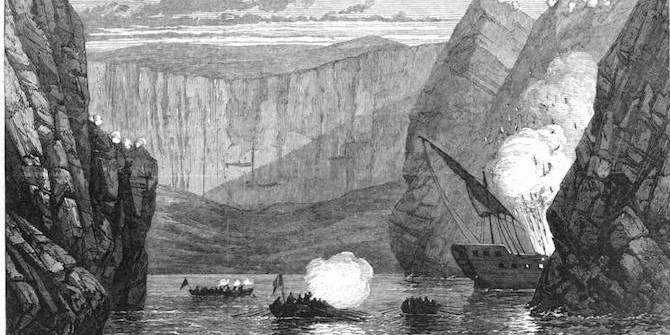by J. E. Peterson
This memo was presented part of a workshop organised by the LSE Middle East Centre on 13 June 2018, looking at Tribe and State in the Middle East.

The question “what is a tribe” is certainly debatable (see Berque) but here the reference is specifically to qabilah in the Arabian Peninsula. Simply put, people are related by their own estimation and those so related may stand together. The fluidity of the qabilah is reflected in its evolving relationship with the dawlah or state.
The tribal role in state formation in the Gulf (Peterson) is most relevant for Kuwait, Bahrain, Qatar, and what is now the UAE. The Gulf littoral in the 18th and 19th centuries saw British-imposed maritime peaces and subsequent exclusive agreements. The consequence was the extension of “supratribal authority” in coastal settlements to recognition of a ruler of territory, however loosely defined. Bahrain provides a partial exception to the pattern because of the way in which the Al Khalifah claimed leadership. Nevertheless, Bahrain was a party to the truces and treaties, and tribes could migrate elsewhere while the tribal nature of the régime itself was reinforced by the recruitment of Najdi tribal allies.
Saudi Arabia derives from tribal leadership (the Al Sa’ud) allied with religious authority (the Al al-Shaykh), but the composition of the state was not settled when the British entered the Gulf scene. ‘Abd al-‘Aziz achieved the unification of much of Arabia with Britain in partial support. Oman’s recent history encompasses friction between tribes and dynasty (in the case of both the Ya’aribah and the Al Bu Sa’id) due to the legacy of the Ibadi imamate. The intensification of the British role in Oman and its alliance with the Al Bu Sa˓id transformed a case of “tribes in the state” into “tribes vs. the state.”
Borders – and therefore territorial domains – in the Gulf were left unsettled until the establishment of air routes (requiring the security of aerodromes) and oil concessions (Peterson). The creation of states in a fuller sense (Said Zahlan) followed. Shaykhly families were transformed into ruling castes (Heard-Bey) and gradually the political role of tribes overall was reduced – in Saudi Arabia in the 1920s and 1930s, in Oman with the putting down of the rebellions from the 1950s to 1970s. Nevertheless, tribalism continues to play a social role (Samin). Persistent distinctions between hadar and badu are more problematic in some states than others, and are particularly important in Kuwait (Nakib).
Reference to tribal heritage underpins national myths in the modern Gulf states despite the long presence of significant non-tribal and even non-Arab communities. Tribal descent is what makes the nationals of these states distinct from the overwhelming Asian, northern Arab, and European populations. Often it underpins citizenship. The ruling family represents, if only in an idealised sense, the apex of the tribal cum national system. The result is a state-tribe symbiosis (Kostiner).
Tribalism remains important in many places, but there is a great difference between the role of tribes in Yemen and in the Gulf. The relationship between tribes and the state in Yemen (Peterson) exemplifies the concepts of both “tribes in the state” and “tribes vs. the state.” No single tribe or family has exercised any paramount authority since the demise of the imamate – and even then, imams tended to exercise a minimalist role for a limited duration. At the end of the civil war of the 1960s, leadership was vested in the country’s most respected statesman, al-Iryani, but despite his moral standing, he was unable to unify Yemen. The result was military leadership and weak attempts to exert state authority over a highly fragmented country, large sectors of which were, when left alone, largely self-governing (Dresch).
This is not so in the Gulf where oil wealth allowed a peaceful transition from the collective responsibility of the tribe to the hierarchical power of the state (Salzman). The dominant role of certain tribal families was largely accepted more than a century ago. Gradually over the course of the oil era, education and socioeconomic change worked to decrease effective dependence on the tribe for protection and advancement and to increase the state’s role. “Tribes vs. the state” is hardly an issue. “Tribes in the state” remained important as shaykhly power and authority evolved into dominance by ruling families. Fossilized leadership was enhanced by a supposed social contract exchanging political voice for economic prosperity.
The experience of the Gulf states in removing the issue of “tribes vs. the state” was shaped by a supportive regional and international environment. For the smaller states, appointment as legitimate ruler by the British led to a consolidation that saw shaykh become hakim and dynasty become regime. Saudi Arabia and Oman followed different patterns later, but all transformation was aided immensely by the advent of oil income.
The six Gulf states are a group of similar monarchies with increasing power and status in a chaotic Arab world. Yemen, though, has encountered enemies on its borders and beyond who interfered with and complicated Yemeni politics at all levels. Saudi Arabia in particular plied Yemeni governments with cash but simultaneously undercut them with substantial handouts to shaykhs throughout the country, who then resisted subordination to the center.
The Gulf states have enjoyed the umbrella support of Britain and the US, cemented by economic and political alliances: rulers are able to act with unchallenged authority on a one-on-one basis with outside powers. Their enemies have been contained and even defeated by the West. Since the 1960s, Yemen has been a battlefield for influence and power by neighbours and outside powers – the present conflict continues the pattern.
In short, the state and maturing nationalism in the Gulf mostly relegates the tribes to genealogical and social importance (Eickelman): tribes have not disappeared but their influence on high policy has been greatly minimised. In Yemen, there is no effective state at present and the preceding Republic of Yemen was a shaky edifice propped up by little more than international recognition and an ability to monopolise rents. As a result, tribes remain essentially independent and are a vital mode of self-identification for many Yemenis.
J. E. Peterson is a historian and political analyst specialising in the Arabian Peninsula and Gulf. He is the author and editor of several books on the Gulf and tribalism, including The Emergence of the Gulf States (2016), Oman’s Insurgencies: The Sultanate’s Struggle for Supremacy (2007) and Historical Dictionary of Saudi Arabia (2003).
Other posts in this Series:
- Introduction by Courtney Freer
- Tribalism in Middle Eastern States: A Twenty-first Century Anachronism? by Richard Tapper
- The Syrian Civil War: What Role do Tribal Loyalties Play? by Haian Dukhan
- Tribes and Tribalism in a Neoliberal Jordan by Jessica Watkins
- From Revolutions to Elections: When Tribes Transform State Power by Alice Wilson
- The Political Decline and Social Rise of Tribal Identity in the GCC by Steffen Hertog
- On Tribalism and Arabia by Andrew Gardner
- Tribal Modern: Branding New Nations in the Gulf by miriam cooke
- Gulf Nationalism and Invented Traditions by Natalie Koch
- Tribal Social Evolution and Gender: Conflict in Urbanized Tribal Units by Alanoud Alsharekh
- Tribal Revival in the Gulf: A Trojan Horse or a Threat to National Identities? by Maryam Al-Kuwari






